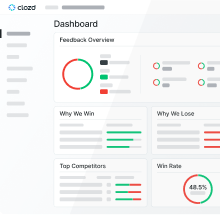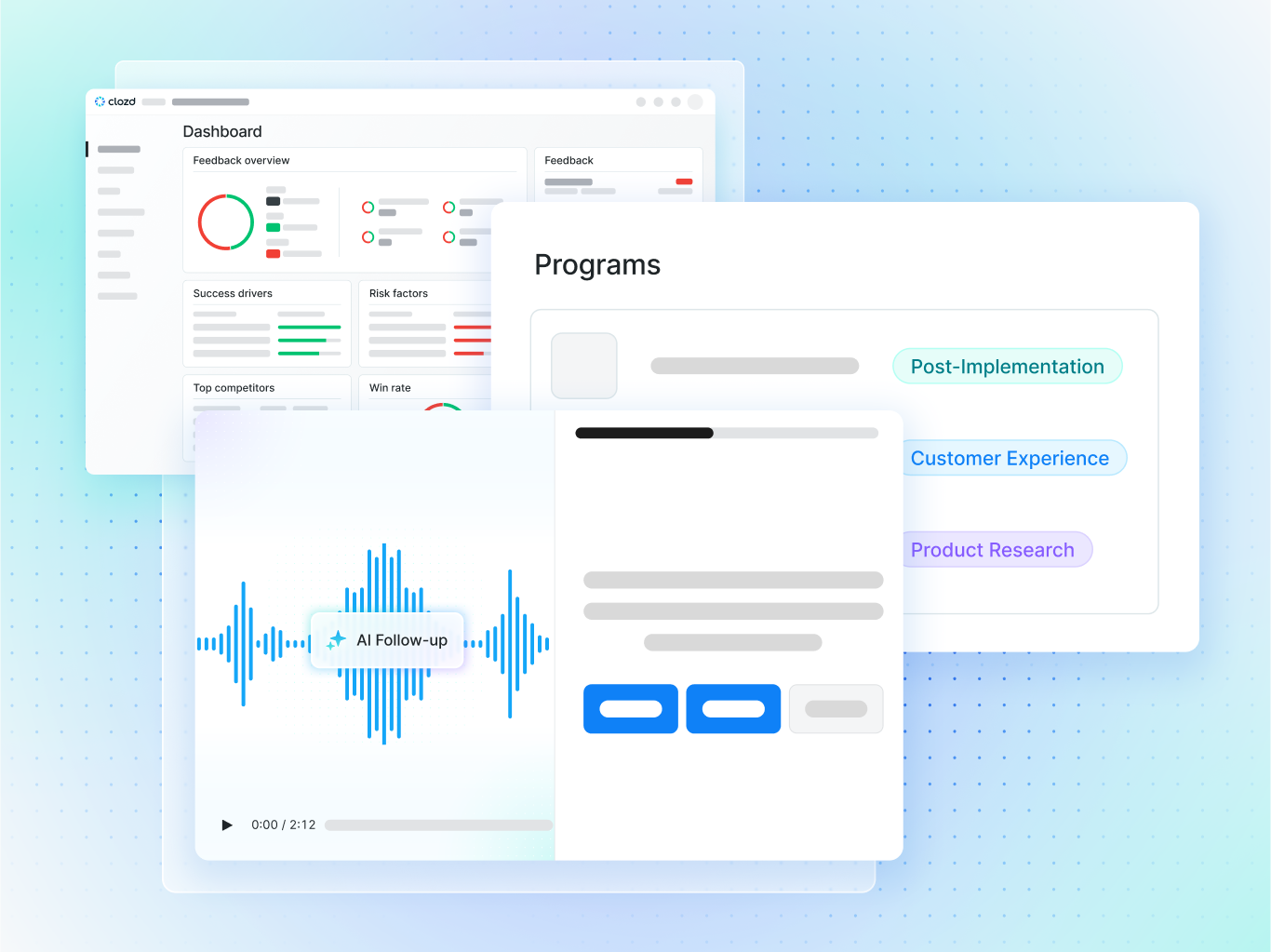As a Head of Product, you're at the helm of your company's most vital asset: its product. Your role isn't just about features; it's about driving strategic growth, ensuring market fit, and delivering tangible business outcomes. In this high-stakes environment, customer feedback isn't merely a nice-to-have; it's a strategic imperative. It's the direct line to understanding market needs, validating your product vision, and ultimately, improving the customer experience in ways that directly impact your bottom line.
This guide will walk you through how to strategically leverage customer feedback to enhance customer experience, ensuring your products and services consistently meet—and exceed—consumer needs. We'll explore how to move beyond simply collecting data to transforming it into actionable insights that shape your product roadmap, empower your product teams, and drive significant business impact.
Why Customer Feedback is Your Strategic Compass
For a Head of Product, customer feedback is more than just a collection of comments; it's a powerful strategic tool. It provides the critical intelligence needed to navigate market complexities, make informed decisions, and ensure your product remains competitive and valuable.
Unlocking Market and Customer Insight
Your product strategy and vision are only as strong as your understanding of the market and your customers. Customer feedback offers a direct window into their world, revealing their true needs, persistent pain points, and unmet expectations.
By actively listening to your customers, you gain a deep understanding of what truly matters to them. This insight is invaluable for:
- Validating Product-Market Fit: Feedback confirms whether your product genuinely solves a problem for your target audience.
- Identifying Emerging Trends: Customers often signal shifts in the market or new opportunities before they become widely apparent.
- Pinpointing Competitive Advantages: Understanding what customers value (or dislike) about your product versus competitors helps you sharpen your unique selling propositions.
This isn't just about making customers happy; it's about building a product that is strategically positioned for long-term success and market leadership.
Driving Business Impact and Key Metrics
The ultimate measure of a Head of Product's success lies in business impact. Customer feedback directly influences the metrics you care about most:
- Revenue Growth: Products that truly meet customer needs lead to higher adoption, increased usage, and ultimately, greater revenue (MRR, ARR, ARPU). Feedback helps identify features that drive upsells or reduce friction in the sales process.
- Customer Retention and Reduced Churn: In the B2B world, retaining existing customers is often more cost-effective than acquiring new ones. Addressing customer pain points identified through feedback is crucial for keeping customers satisfied and reducing churn. Happy customers are loyal customers.
- Optimizing Customer Lifetime Value (LTV) and Customer Acquisition Cost (CAC): By improving the product experience, you increase LTV. When customers are satisfied, they become advocates, reducing your CAC through referrals and positive word-of-mouth.
- Product Adoption and Engagement: Feedback helps you understand why customers use certain features and ignore others. This knowledge allows you to refine the user experience, making the product more intuitive and valuable, thereby boosting adoption and engagement.
When you use customer feedback strategically, you're not just improving features; you're directly impacting the financial health and growth trajectory of your business.
Fostering Continuous Improvement and Innovation
The B2B landscape is constantly evolving. To stay ahead, your product must also evolve. Customer feedback is the engine of continuous improvement and a catalyst for innovation.
It helps product teams:
- Identify Weak Points: Feedback highlights areas where the product falls short, allowing you to prioritize fixes and enhancements.
- Discover Opportunities for New Features: Customers often articulate needs that can be translated into valuable new features, expanding your product's capabilities and market reach.
- Refine Existing Functionality: Even well-loved features can be improved. Feedback provides the nuances needed to make good features great, enhancing the overall user experience.
By embedding feedback into your product development lifecycle, you ensure your product remains relevant, valuable, and innovative, consistently delivering a superior customer experience.
Building a Robust Customer Feedback Loop
A truly effective customer feedback strategy isn't about sporadic data collection; it's about establishing a systematic, ongoing feedback loop. This loop ensures that customer insights are continuously gathered, analyzed, and acted upon, becoming an integral part of your product development process.
Defining Your Feedback Goals
Before you start collecting feedback, clarify what you aim to achieve. Without clear goals, you risk gathering a lot of data that doesn't lead to actionable insights. As a Head of Product, your goals should align with your broader product strategy and business objectives.
Ask yourself:
- What specific questions do we need answered to inform our next strategic move?
- Are we trying to validate a new feature idea, understand churn drivers, or identify areas for user experience improvement?
- How will this feedback help us achieve our revenue, retention, or adoption targets?
Well-defined goals ensure your feedback collection efforts are focused and efficient, leading directly to insights that matter for your product roadmap.
Collecting Rich Customer Feedback: Beyond Surveys
Effective feedback collection requires a multi-faceted approach, combining both quantitative and qualitative methods. While numbers tell you what is happening, qualitative insights explain why.
Quantitative Methods: The "What"
These methods provide measurable data, helping you track trends and identify areas needing attention.
- Surveys:
- Net Promoter Score (NPS): Measures customer loyalty and willingness to recommend.
- Customer Satisfaction (CSAT): Gauges satisfaction with specific interactions or the product overall.
- Customer Effort Score (CES): Assesses the ease of using a product or resolving an issue.
- While valuable for benchmarking and high-level sentiment, surveys often provide surface-level data. They tell you that a customer is unhappy, but rarely why in sufficient detail.
- In-App Feedback and Usage Analytics: Tools embedded directly within your product allow users to submit feedback in real-time or track their interactions. This data provides insights into feature adoption, common workflows, and points of friction.
- Social Media Monitoring: Keeping an eye on social channels can reveal unsolicited feedback, sentiment, and emerging issues that customers are discussing publicly.
Qualitative Methods: The "Why" and the "How"
For a Head of Product, understanding the "why" behind the "what" is paramount. Qualitative feedback provides the depth and context needed to truly understand customer needs and pain points.
- Customer Interviews: One-on-one interviews or small focus groups are incredibly powerful. They allow for open-ended questions, follow-up probes, and the ability to uncover nuanced perspectives that surveys simply can't capture. This is where you hear the stories, the frustrations, and the aspirations directly from your customers.
- This is where Clozd excels. For B2B companies, conducting in-depth, unbiased customer interviews can be resource-intensive and challenging to execute consistently. Clozd specializes in providing rich insights through expertly conducted customer interviews. We go beyond surface-level questions to uncover the true motivations, pain points, and unmet needs that drive customer decisions. Our structured interview process and analytical capabilities provide you, as a Head of Product, with deep, actionable qualitative data. This allows you to understand not just what customers want, but why they want it, and how it impacts their business, giving you a significant strategic advantage in improving your products and customer experience.
- User Testing and Usability Sessions: Observing customers as they interact with your product reveals usability issues and unexpected behaviors.
- Sales and Customer Support Interactions: Your sales and customer service teams are on the front lines, hearing customer feedback daily. Establish structured processes for them to capture and relay common questions, complaints, and feature requests. These teams often have invaluable insights into customer pain points and the competitive landscape.
By combining these methods, you create a comprehensive picture of the customer experience, moving from broad trends to specific, actionable insights.
Centralizing and Organizing Feedback
Collecting feedback is only the first step. To make it useful, you need a system to centralize, categorize, and organize it. Imagine trying to build a product roadmap from scattered emails, spreadsheets, and Slack messages – it's impossible.
- Single Source of Truth: Implement a dedicated feedback management system or tool. This ensures all feedback, regardless of its source, resides in one accessible location.
- Categorization and Tagging: Develop a consistent taxonomy for tagging feedback. Categorize by:
- Product area or feature
- Customer segment
- Severity or impact
- Customer journey stage (e.g., onboarding, daily use, support)
- Sentiment (positive, negative, neutral) This structured approach makes it easier to analyze large volumes of feedback, identify patterns, and prioritize effectively.
Analyzing Customer Feedback for Actionable Insights
Collecting feedback is just data. The real value emerges when you transform that data into actionable insights. This analytical phase is where a Head of Product truly shines, translating raw input into strategic direction.
Identifying Patterns and Trends
Individual pieces of feedback are important, but the power lies in recognizing recurring themes. As a Head of Product, you're looking for systemic issues and widespread opportunities, not just one-off requests.
- Look Beyond the Noise: Don't get bogged down by every single complaint. Instead, use your organized feedback to identify common threads. Are multiple customers reporting the same bug? Are several expressing a need for a similar new feature?
- Data-Driven Approaches: Leverage your categorization system to filter and sort feedback. Tools can help visualize trends, showing you which product areas receive the most feedback, what the prevailing sentiment is, or which customer segments are most vocal.
- Segmenting Feedback: Analyze feedback through different lenses. How does feedback from enterprise clients differ from that of small businesses? What are the pain points for new users versus long-term customers? This segmentation helps you tailor solutions to specific customer needs and strategic priorities.
By identifying these patterns, you move from reactive problem-solving to proactive, strategic product development.
Prioritizing Feedback for Maximum Impact
As a Head of Product, you're constantly balancing competing demands. Not all feedback is created equal, and you can't implement every suggestion. Prioritization is critical to ensure your product teams focus on initiatives that will deliver the biggest business impact.
- Align with Product Strategy and Business Goals: Every piece of feedback considered for implementation should be weighed against your overarching product strategy and key business objectives. Will addressing this feedback contribute to revenue growth, reduce churn, or improve LTV? If not, it might not be a priority right now.
- Frameworks for Prioritization: Utilize established frameworks to objectively assess and prioritize.
- RICE (Reach, Impact, Confidence, Effort): Quantifies the potential value and effort of an initiative.
- MoSCoW (Must-have, Should-have, Could-have, Won't-have): Categorizes requirements based on their importance.
- Impact vs. Effort Matrix: A simple visual tool to plot initiatives and identify quick wins versus strategic investments.
- Balancing Short-Term and Long-Term Goals: Some feedback points to immediate, critical fixes (e.g., a major bug impacting core functionality). Others suggest long-term strategic investments (e.g., a new product line). As a Head of Product, you must balance these, ensuring you address immediate customer pain points while also investing in the future of your product.
- How to Say "No" Effectively: It's impossible to implement every request. Learning to say "no" (or "not right now") gracefully, while explaining the strategic rationale, is a crucial skill. This manages expectations and keeps your product teams focused on high-priority items.
Effective prioritization ensures that your resources are allocated to initiatives that truly move the needle for your customers and your business.
Translating Feedback into Product Requirements
Raw customer feedback, while valuable, isn't directly usable by engineering teams. Your role, and that of your product managers, is to translate this feedback into clear, concise, and actionable product requirements.
- Focus on the "Why": Instead of simply stating "customers want X feature," articulate the underlying problem X feature solves and the value it provides. This context helps product teams understand the customer's perspective and design more effective solutions.
- Define User Stories: Frame requirements as user stories (e.g., "As a [type of user], I want to [action], so that [benefit]"). This keeps the customer at the center of the development process.
- Specify Acceptance Criteria: Clearly define what success looks like for each requirement. This ensures that the implemented solution truly addresses the feedback and meets customer expectations.
This translation process is critical for bridging the gap between customer needs and product development, ensuring that the solutions built are truly impactful.
Implementing Feedback: From Insight to Improved Customer Experience
The analysis phase culminates in action. This is where insights transform into tangible product improvements that directly enhance the customer experience and drive business value.
Integrating Feedback into the Product Roadmap
Your product roadmap is the strategic blueprint for your product's future. Customer feedback should be a primary input, directly influencing what gets built and when.
- Strategic Alignment: Ensure that feedback-driven initiatives on the roadmap align with your overall product strategy and business objectives. The roadmap should reflect a balance of addressing current pain points, enhancing existing features, and innovating with new capabilities.
- Collaborative Planning: Work closely with engineering, design, and marketing teams to integrate feedback into the roadmap. This cross-functional collaboration ensures that technical feasibility, design considerations, and go-to-market strategies are all factored in.
- Dynamic and Iterative: The roadmap isn't static. As new feedback emerges and market conditions change, be prepared to iterate and adjust your plans. This agility is key to continuous improvement.
By embedding feedback into your roadmap, you ensure that your product development efforts are always customer-centric and strategically sound.
Empowering Product Teams to Act
As a Head of Product, you lead the charge, but your product managers and their teams are the ones executing. Empowering them with clear insights and a customer-centric culture is essential.
- Provide Context and Data: Don't just hand over a list of features. Provide your product managers with the raw feedback, the analysis, and the strategic rationale behind prioritization decisions. This helps them understand the "why" and make better design and development choices.
- Foster a Customer-Centric Culture: Encourage your teams to regularly engage with customer feedback, whether through reading interview transcripts, listening to support calls, or participating in user testing. This direct exposure builds empathy and a shared commitment to improving the customer experience.
- Iterative Development: Promote an agile, iterative approach to product development. This allows for smaller, more frequent releases, enabling you to gather feedback on new features quickly and make rapid adjustments.
When product teams are empowered with customer insights, they build better products that resonate more deeply with users.
Measuring the Impact of Changes
Implementing changes based on feedback is only half the battle. To truly understand if your efforts are successful, you must measure their impact. This data-driven approach validates your decisions and informs future iterations.
- Track Key Metrics: After implementing a feedback-driven improvement, monitor the relevant metrics. Did NPS scores improve? Did CSAT for specific interactions increase? Has churn decreased for a particular segment? Is product adoption or engagement up for the new feature?
- A/B Testing: For significant changes or new features, consider A/B testing to compare the performance of the new version against the old. This provides objective data on which approach is more effective.
- Quantify ROI: Whenever possible, quantify the return on investment (ROI) of your feedback-driven improvements. For example, if a feature enhancement reduced support tickets by X%, what is the cost saving? If it led to Y% higher conversion, what is the revenue impact? This demonstrates the tangible business value of your feedback strategy.
Measuring impact closes the loop on your implementation efforts, providing concrete evidence of improved customer experience and business outcomes.
Closing the Loop: Communicating and Iterating
The feedback loop isn't complete until you communicate back to your customers and internal stakeholders. This crucial step builds trust, reinforces your commitment to customer satisfaction, and ensures continuous improvement.
Communicating Back to Customers
Customers who take the time to provide feedback want to know it's been heard and acted upon. Closing the loop with them is a powerful way to build loyalty and advocacy.
- Show Appreciation: Always thank customers for their input.
- Share Updates: Inform customers about the changes you've made based on their feedback. This can be through:
- In-app messages or notifications: For product-wide improvements.
- Release notes: Detailing new features and fixes.
- Direct follow-up: For specific individuals who provided detailed feedback on an issue you've resolved.
- Build Trust and Loyalty: When customers see their input leading to tangible improvements, it reinforces their belief that you value their business and are committed to their success. This fosters a stronger relationship and reduces the likelihood of churn.
This transparency transforms customers from passive users into active partners in your product's evolution.
Internal Communication and Stakeholder Alignment
As a Head of Product, you're a central hub, connecting various departments. Effective internal communication about customer feedback and its impact is vital for cross-functional alignment.
- Share Insights Broadly: Regularly share key customer insights and the resulting product improvements with sales, marketing, customer support, and executive leadership.
- Reinforce Product Vision: Show how feedback-driven changes align with and advance the overall product vision and company strategy.
- Manage Expectations: Keep stakeholders informed about what feedback is being prioritized and why, as well as what's on the roadmap for future consideration. This prevents miscommunication and ensures everyone is working toward unified goals.
When everyone in the organization understands the voice of the customer and how it's shaping the product, it creates a more cohesive and customer-centric company culture.
The Cycle of Continuous Improvement
Customer feedback is not a one-time project; it's an ongoing, iterative process. The B2B market, customer needs, and competitive landscape are constantly shifting. Your feedback loop must be dynamic to keep pace.
- Regular Review and Refinement: Periodically review your feedback collection methods, analysis processes, and prioritization frameworks. Are they still effective? Are you getting the insights you need?
- Adapt and Evolve: Be prepared to adapt your strategy as your product matures or your business goals shift. New product lines might require different feedback channels or analytical approaches.
- Embed in Culture: Ultimately, the goal is to embed the continuous use of customer feedback into the DNA of your product organization. It should be a natural, expected part of how you operate, from strategic planning to daily development tasks.
By embracing this cycle, you ensure your product remains relevant, competitive, and continuously optimized to deliver an exceptional customer experience.
Your Product's Future is Customer-Driven
As a Head of Product, your strategic leadership is paramount to your company's success. By systematically leveraging customer feedback, you gain an unparalleled advantage. You're not just building features; you're building solutions that directly address market needs, drive business growth, and cultivate lasting customer loyalty.
Embrace customer feedback as your most valuable strategic asset. It's the compass that guides your product vision, the fuel that powers your product teams, and the ultimate driver of an exceptional customer experience. Start building or refining your feedback strategy today, and watch your product—and your business—thrive.











.svg)












.svg)

.svg)




